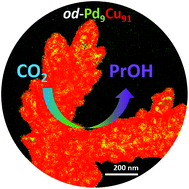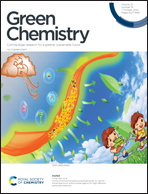Selective n-propanol formation from CO2 over degradation-resistant activated PdCu alloy foam electrocatalysts†
Abstract
We present a novel, foam-type, high surface area electrocatalyst for the CO2 reduction reaction (CO2RR) that is not only highly selective toward n-propanol (PrOH) formation (FEPrOH = 13.7%, jPrOH = −1.15 mA cm−2) at relatively low overpotentials (−0.65 V vs. RHE) but also demonstrates an excellent long-term stability during CO2 electrolysis experiments of 102 h in duration. A dynamic hydrogen bubble template approach is applied to electrodeposit a binary PdCu alloy foam yielding a nominal bulk composition of 9 at% Pd and 91 at% Cu (denoted as Pd9Cu91). The material is further modified by means of thermal annealing (12 h at 200 °C in air), which completely transforms the as-prepared metallic Pd9Cu91 alloy foam into its oxidic state. The ultimate catalyst activation is achieved by subsequent reduction (at −0.65 V vs. RHE for 45 min) of the oxidic precursors (composite of Cu2O, CuO, and CuPdO3) into metallic state, as indicated by operando Raman spectroscopy. Identical location scanning electron microscopy (IL-SEM) analysis, carried out prior to and after the activation treatments, demonstrates significant morphological alterations of the Pd9Cu91 foam on the nm length scale, which go along with a phase segregation into nm-range Pd-rich and Cu-rich domains that helps to increase the PrOH selectivity. Time-dependent ICP-MS analyses of the electrolyte solution, carried out during the catalyst activation, demonstrate preferential (rapid) Cu dissolution followed by (slow) Cu redeposition on the catalyst surface. These processes are found to be superimposed on the actual oxide reduction. A two-fold selectivity of PrOH was observed over ethanol (EtOH). The excellent long-term stability of the activated Pd9Cu91 foam catalyst is rationalized by the full suppression of the C1 hydrocarbon (methane) pathway. The improved product selectivity towards the highly valuable C3 alcohol is rationalized by an efficient and concerted spillover of chemisorbed carbon monoxide (*CO) and atomic hydrogen (*H) species from the Pd-rich domains to the activated Cu-rich domains of the oxide-derived Pd9Cu91 foam catalyst where the C–C coupling and subsequent hydrogenation processes take place to form the targeted oxygenate product.



 Please wait while we load your content...
Please wait while we load your content...